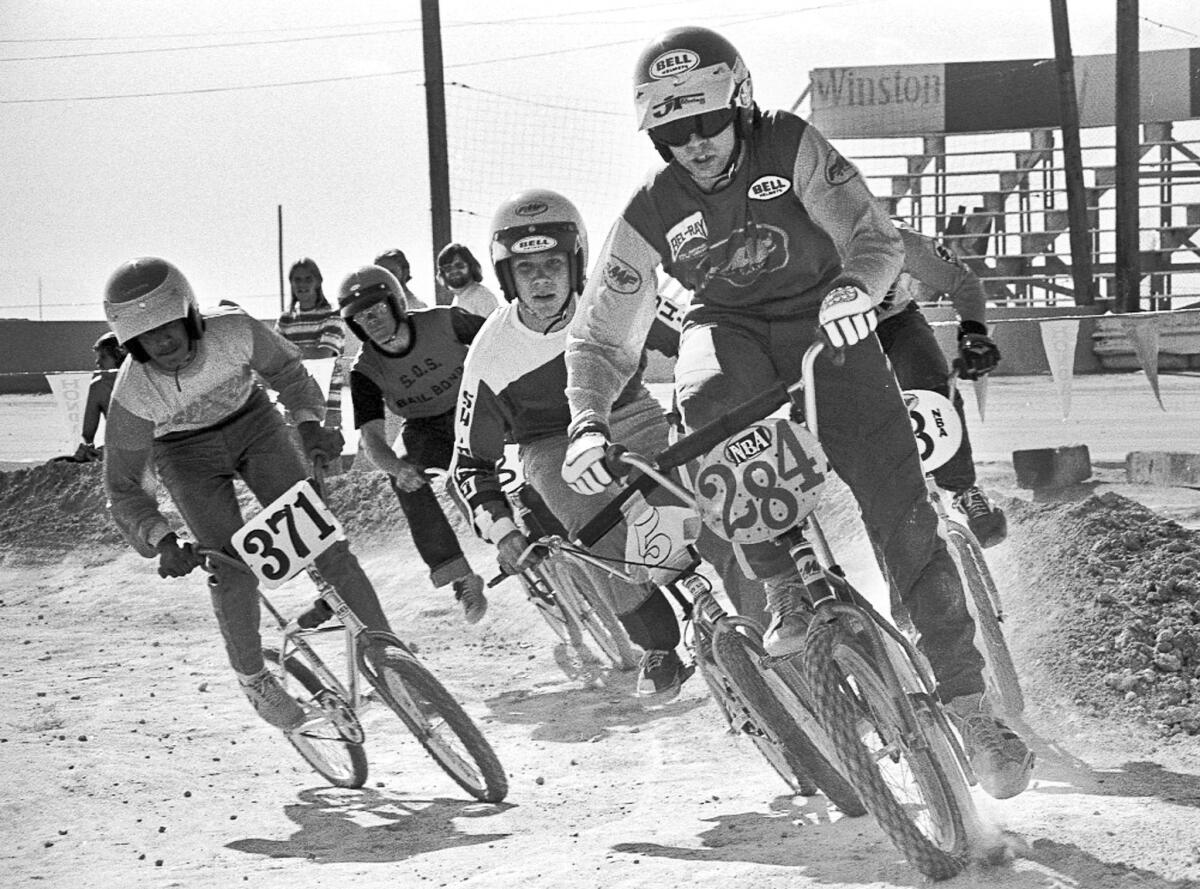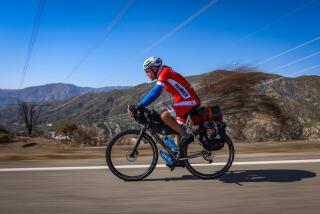Scot Breithaupt dies at 57; started global BMX craze in Long Beach

- Share via
The vacant lot near the corner of 7th Street and Bellflower Boulevard in Long Beach was perfect for the young Scot Breithaupt.
Amid run-down Quonset huts and maintenance shacks for the nearby oil wells, Breithaupt cut a few dusty trails through the weeds with his bicycle, invited friends over and helped start a craze that in time would transfix the world.
The renegade races that Breithaupt organized on that dirt lot soon evolved into BMX — bicycle motocross — a sport that draws hundreds of thousands of enthusiasts and, in 2008, debuted in China in the Olympics.
Admired for his skills as a rider, Breithaupt was also a key promoter, co-founding a trade magazine, establishing a professional organization for BMX racers and developing components for the bicycles.
Breithaupt, 57, was found dead in a tent in a vacant lot in Indio on Saturday evening, authorities said. The Riverside County coroner is investigating the circumstances of his death.
Much as Hobie Alter transformed sailing, surfing and skateboarding in the 1960s, Breithaupt radicalized — and popularized — bicycle riding by borrowing from the off-road skills of motorcyclists.
“He was an entrepreneurial teenage kid, but just always going at 100 miles per hour and super energetic,” said Craig Barrette, a spokesman with the international BMX racing organization, USA BMX. “With his contagious enthusiasm for this new sport called BMX, his races just kind of got bigger and bigger.”
By the age of 12, Breithaupt was racing a Yamaha in motocross competitions, and according to his brother, Jeffrey, was having so much fun that he thought other kids should experience the sport.
But not everyone could afford a motorcycle. Pedal-cross — as Breithaupt first called it — became the alternative, and the Stingray bicycle with smaller wheels than traditional bikes was suited to quick and agile maneuvering. Soon Breithaupt and other Southern Californians were perfecting long wheelies and distance jumping on dirt tracks.
With the natural charisma and energy of a rock ‘n’ roll promoter, Breithaupt took BMX racing onto a national stage.
“Scot Breithaupt should be credited with figuring out a way for organizing … BMX events for what we have today,” said Harry Leary, a pro BMX rider.
Even though his life was clouded by addiction — and in later years, incarceration — Breithaupt stayed committed to the sport and the lessons it taught him.
“I failed miserably in a lot of things, but I had a lot of successes,” he said in the 2005 film, “Joe Kid on a Stingray: The History of BMX.”
He was born in Long Beach on July 14, 1957. His mother, Carole Faye Breithaupt, was the first Miss Long Beach in the Miss America pageant in 1950. His father, Leo Breithaupt, was a small-track race car driver, who competed in the California Jalopy Assn.
Scot was always taking risks, his brother recalled, riding his bicycle off the roof of the junior high school cafeteria and the top of a house into a swimming pool.
Well before graduating from high school, Breithaupt had begun to design BMX tracks for cities in Los Angeles and Orange counties.
“He was a kid — all of us were kids who were doing the sport at the time,” said John Swarr, co-director and co-writer of “Joe Kid on a Stingray.” “He was the one who was able to bring it out and bring it up and really grow it faster.”
BMX races quickly became a venue for daredevil tricks, fierce competition and rabid fanaticism. It was not uncommon, Breithaupt once said, for a competitor to “take a stick and try to put it in the other guy’s spokes.”
As teams formed, Breithaupt was at the center of the action. While still in high school, he found a promoter who fronted $100,000 for a series of races that culminated with a state championship at the Los Angeles Memorial Coliseum in 1974. The track had water holes and banked turns, and, according to Breithaupt, the races attracted 16,000 spectators with almost 1,100 riders per event.
Soon rivalries developed between West and East Coast teams, and Breithaupt was taking a cadre of young riders on the road to national competitions. He would charge $600 for a position on the bus, ostensibly to cover the costs of food, lodging and gas, but as one rider once described the scene, the team was well schooled in the dine-and-dash strategy.
By his early 20s, Breithaupt was considered the old man of BMX racing, the godfather of the sport. His voice of experience was called upon in a magazine column that he wrote for BMX Action, in which he helped define and perpetuate the “Cult of Gnarly.”
He co-founded the company, SE Racing, promoting BMX with teams of riders, designing bicycle frames and developing special tubing for bike frames for competitive bikes.
“I was just a kid with a vision,” he said.
In later years, that vision became harder to follow. The sport had evolved: Racing on dirt tracks became less appealing than the free-styling vertical assaults favored by X-Game promoters. Olympic medals and million-dollar sponsorships transformed the field.
In the 1980s, according to his brother, Scot had become addicted to crack cocaine. He lost control of SE Racing, and in a 2012 posting on the website, fatBMX, he described a recent set of problems that included treatment for cancer as well as claims against the state corrections agency.
His brother said that although Scot had been living with his mother in La Quinta, he would disappear for days.
“He was a remarkable guy,” Jeffrey Breithaupt said. “Drugs were his torment.”
In addition to his brother, he is survived by two sons, Scot and Brandon Breithaupt; a sister, Lynda Muenzer; and his mother.
Times staff writers Alexander Shultz and Greg Hadley contributed to this report.
More to Read
Start your day right
Sign up for Essential California for the L.A. Times biggest news, features and recommendations in your inbox six days a week.
You may occasionally receive promotional content from the Los Angeles Times.







